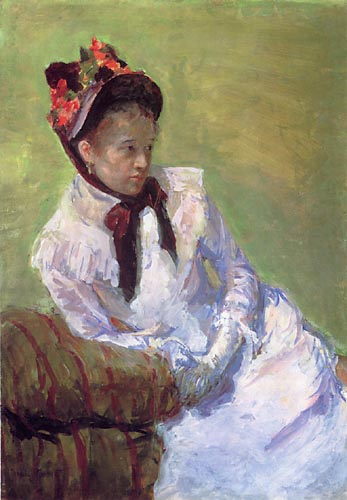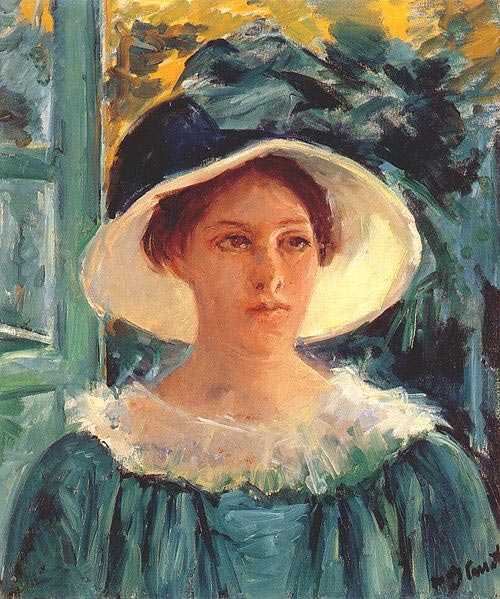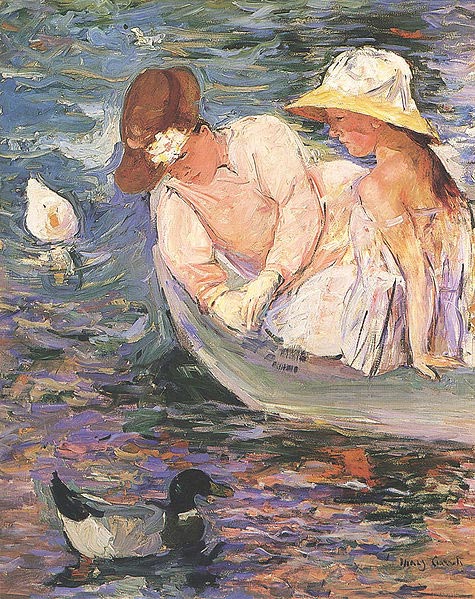| Mary Cassatt | |
|---|---|
 |
|
| Born | May 22, 1844 Allegheny City, Pennsylvania, United States |
| Died | June 14, 1926 (at age 82) Château de Beaufresne, near Paris, France |
| Nationality | American |
| Education | Pennsylvania Academy of the Fine Arts, Jean-Léon Gérôme, Charles Chaplin, Thomas Couture |
| Movement | Impressionism |
| Field | Painting |
| Works | View Complete Works |
One of the famous art movements is Impressionism. It started from a group of independently exhibiting artists in Paris. This particular art movement is characterized by comparably thin and small but visible brush strokes, accurate depiction of light and its altering qualities, open composition, unusual visual angles, common subject matter, and inclusion of movement as an integral element. One artist known in the Impressionist movement was Mary Cassatt.
Mary Stevenson Cassatt was a painter who, though really from America, spent a good deal of her adulthood in France, where she exhibited her art. Her works were usually depictions of lives of women, both private and social, most giving weight to the connection of mothers and their children.
Mary Cassatt was born on May 22, 1844 in Allegheny, Pennsylvania, which is now a part of Pittsburgh. Her family was favorable. Her father, by the name of Robert Simpson Cassatt, was a successful land speculator and stockbroker. Katherine Kelso Johnston, her mother, was from a banking family. She had six siblings, although two died when they were infants. Later on, they moved to the east, eventually to Philadelphia area but to Lancaster before that. She started school when she was six.
 In the milieu where she grew up, travel was believed to be a critical part of education. With that, she went to Europe and spent five years there – visiting capitals which included London, Berlin and Paris. In her travels, she learned French and German and she also had her initial trainings in drawing and music. She probably encountered French artists such as Corot, Delacroix, Ingres and Courbet at the Paris World’s Fair of 1855. Degas and Pissarro were also in that exhibition. Both of them would later become her mentors and colleagues.
In the milieu where she grew up, travel was believed to be a critical part of education. With that, she went to Europe and spent five years there – visiting capitals which included London, Berlin and Paris. In her travels, she learned French and German and she also had her initial trainings in drawing and music. She probably encountered French artists such as Corot, Delacroix, Ingres and Courbet at the Paris World’s Fair of 1855. Degas and Pissarro were also in that exhibition. Both of them would later become her mentors and colleagues.
Despite her family’s objection to her taking the path of a professional artist, Cassatt entered the Pennsylvania Academy of Fine Arts at the age of 15. Her parents were concerned likely because of her exposure to feminism and the bohemian attitude of some male students. Most of the female students viewed art as a socially crucial skill, although they only comprise 20 percent of the students. However, only few of them were as determined as Cassatt to turn art into a career. Through the duration of the American Civil War, she continued her studies. Thomas Eakins, who later became the Academy’s controversial director, was one of her fellow students back then.
 Cassatt later on grew impatient with how slow the instruction was going, along with the demeaning attitude of teachers and male students. With this, she decided to learn the old masters by herself. Also, she commented that teaching was absent from the Academy. Female students were not allowed to use live models until later and most of the training was done by drawing from casts.
Cassatt later on grew impatient with how slow the instruction was going, along with the demeaning attitude of teachers and male students. With this, she decided to learn the old masters by herself. Also, she commented that teaching was absent from the Academy. Female students were not allowed to use live models until later and most of the training was done by drawing from casts.
Cassatt decided to stop her studies – no degree was given. Then, she left for Paris in 1866, after winning over her father’s objections. Her mother and family friends went with her as chaperones. At that time, women were not yet allowed to attend École des Beaux-Arts. Instead, she opted to study in private with school masters. She was accepted to train with Jean-Léon Gérôme, who was renowned for his works on exotic matters and techniques on hyper-realism. To supplement her lessons, she became a copyist at the Louvre – she worked as one of the usually low-paid women who frequented museums to paint copies.
At the end of 1866, she enlisted in a painting class with Charles Chaplin, a remarkable genre artist, as its teacher. In 1868, Cassatt also trained with an artist working on romantic and urban subject matter by the name of Thomas Couture. Students went on countryside trips where they drew from life, mostly peasants working. Cassatt’s painting was accepted for the first time for the Paris Salon. The painting was entitled A Mandolin Player which is Romantic in style. This is one of the only two works from the first decade of her career that was documented.
 Mary Cassatt returned to the United States when the Franco-Prussian War was just beginning in 1870. She lived with her family in Altoona. Her father was still against her chosen career. He provided her basic needs but didn’t pay for her art supplies. She submitted two of her paintings which were placed at the New York Gallery. This gave her lots of admirers but no buyers. In addition to her disappointment, she couldn’t find paintings to study at home. There came a point when she thought about giving up art and finding employment. She traveled to Chicago to try her luck. Then, she was commissioned by the Archbishop of Pittsburgh to paint copies of a painting by Correggio. She earned enough money to go back to Europe.
Mary Cassatt returned to the United States when the Franco-Prussian War was just beginning in 1870. She lived with her family in Altoona. Her father was still against her chosen career. He provided her basic needs but didn’t pay for her art supplies. She submitted two of her paintings which were placed at the New York Gallery. This gave her lots of admirers but no buyers. In addition to her disappointment, she couldn’t find paintings to study at home. There came a point when she thought about giving up art and finding employment. She traveled to Chicago to try her luck. Then, she was commissioned by the Archbishop of Pittsburgh to paint copies of a painting by Correggio. She earned enough money to go back to Europe.
Her art career slowly built up from then. She gained good reputation and her paintings were being purchased. One of her works is The Child’s Bath. The painting shows a mother giving a bath to her child. Its subject and perspective was intuitive of Japanese woodblocks. The painting is now in the Art Institute of Chicago and one of the most popular in the said museum.
The influence of Mary Cassatt in the world of art and beyond extends to a notable reach. A ship for the World War II was named after her. One of her works, titled The Boating Party, was printed on a US postage stamp in 1966. Her paintings have been sold for as high as $2.9 million.